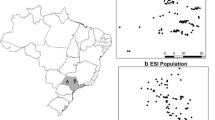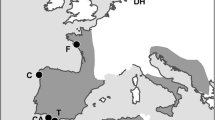Abstract
The role of the individual origin of seeds in the variability of demographic parameters within a seed-bank has been little studied despite the recognition of its important contribution to species adaptation strategies to environmental constraints. This study analyzed the seed-bank dynamics of Cytisus scoparius, a small woody species with a high aptitude for colonization and dominance. Our experimental setup made it possible to monitor seed emergence dynamics in situ for maternal individuals within the study population. In addition to the characteristic traits of the species (maximum seed life span between 4 and 5 years in 75 % of the cases), there was a high variability of the emergence dynamics between individuals, distinguished both by their total emergence rate and profile. The total emergence rate of seeds was correlated with their quality (seed weight and number of seeds per pod), but was unrelated to either maternal age or fecundity. Different emergence profiles can be recognized between two distinct patterns: on one hand, a strategy that concentrates on emergence in the second year and, on the other, a regular decrease of the germinant number over time. The coexistence of different seed-bank strategies between individuals results in the ability for the population to face to disturbances and environmental variability.





Similar content being viewed by others
References
Adams VM, Marsh DM, Knox JS (2005) Importance of the seed-bank for population viability and population monitoring in a threatened wetland herb. Biol Conserv 124:425–436
Barberi P, Macchia M, Bonari E (1998) Comparison between the seed extraction and seedling emergence methods for weed seed-bank evaluation. Aspects Appl Biol 51:9–14
Baskin CC, Baskin JM (1998) Seeds: ecology, biogeography and evolution of dormancy and germination. Academic Press, New York
Baskin JM, Baskin CC (2004) A classification system for seed dormancy. Seed Sci Res 14:1–16
Batlla D, Benech-Arnold RL (2007) Predicting changes in dormancy level in weed seed soil banks: implications for weed. Crop Prot 26:189–197
Bossard CC, Rejmanek M (1994) Herbivory, growth, seed production and resprouting of an exotic invasive shrub Cytisus scoparius. Biol Conserv 67:193–200
Cavers PB (1983) Seed demography. Can J Bot 61:3578–3590
Cohen D (1966) Optimizing reproduction in a randomly varying environment. J Theor Biol 12:119–129
Colbach N, Busset H, Yamada O, Dürr C, Caneill J (2006) AlomySys: modelling black-grass (Alopecurus myosuroides Huds.) germination and emergence, in interaction with seed characteristics, tillage and soil climate. II. Evaluation. Eur J Agron 24:113–128
Colbry VL, Swofford TF, Moore RP (1961) Tests for germination in the laboratory. In: Stefferd A (ed) Yearbook of agriculture. United States Department of Agriculture, Washington, DC, pp 433–443
Ellner S (1985) ESS germination strategies in randomly varying environments. II. Reciprocal yield-law models. Theor Popul Biol 28:80–116
Fenner M, Thompson K (2005) The ecology of seeds. Cambridge University Press, Cambridge
Gardarin A, Dürr C, Colbach N (2011) Prediction of germination rates of weed species: relationships between germination speed parameters and species traits. Ecol Model 222(3):626–636
Grundy AC, Mead A (2000) Modelling weed emergence as a function of meteorological records. Weed Sci 48:594–603
Gutterman Y (1982) Phenotypic maternal effect of photoperiod on seed germination. In: Khan AA (ed) The physiology and biochemistry of seed development, dormancy and germination. Elsevier Biomedical Press, Amsterdam, pp 67–79
Harper J (1977) Population biology of plants. Academic Press, London
Hosking JR, Smith JMB, Sheppard AW (1996) The biology of Australia weeds. Cytisus scoparius (L.) link subsp. scoparius. Plant Prot Quarterly 11:102–107
Klinkhamer PGL, Jong TJ, Metz JAJ, Val J (1987) Life history tactics of annual organisms: the joint effects of dispersal and delayed germination. Theor Popul Biol 32:127–156
Leck MA, Schütz W (2005) Regeneration of Cyperaceae, with particular reference to seed ecology and seed-banks. Perspect Plant Ecol Evolut Syst 7:95–133
Lembicz M, Olejniczak P, Zukowski W, Bodganowicz AM (2011) Effect of mother plant age on germination and size of seeds and seedlings in the perennial sedge Carex secalina (Cyperaceae). Flora 206:158–163
Lundberg S, Nilsson P, Fagerstrog MT (1996) Seed dormancy and frequency dependent selection due to sib competition: the effect of age-specific gene expression. J Theor Biol 183:9–17
Magda D, Chambon-Dubreuil E, Agreil C, Gleizes B, Jarry M (2009) Demographic analysis of a dominant shrub (Cytisus scoparius): prospects for encroachment control. Basic Appl Ecol 9:631–639
Mamo N, Mihretu M, Fekadu M, Tigabu M, Teketay D (2006) Variation in seed and germination characteristics among Juniperus procera populations in Ethiopia. For Ecol Manage 225:320–327
Mayer AM, Poljakoff-Mayber A (1975) The germination of seeds. Pergamon Press, Oxford
Memmott J, Fowler SV, Syret P, Hosking J (1993) What makes broom a major problem? Br Crop Prot Con Weeds 753–78
Meyer SE, Debaene-Gill SB, Band PS, Allen PS (2000) Using hydrothermal time concepts to model seed germination response to temperature, dormancy loss, and priming effects in Elymus elymoides. Seed Sci Res 10:213–223
Morris WF, Doak DF (2002) Quantitative conservation biology: theory and practice of population viability analysis. Sinauer Associates Inc, Sunderland
Paynter Q, Fowler S, Memmott J, Shaw RH, Sheppard AW (2000) Determinants of broom (Cytisus scoparius (L.) Link) abundance in Europe. Plant Prot Q 15:149–155
Pekrun C, Lane PW, Lutman PJW (2005) Modelling seedbank dynamics of volunteer oilseed rape (Brassica napus). Agric Syst 84:1–20
Peterson DJ, Prasad R (1998) The biology of Canadian weeds Cytisus scoparius (L.) Link. Can J Plant Sci 78:497–504
Post BJ, Van Oeveren H (1998) Effect of date of sampling and germination temperature on seedbank estimated of arable weed species. Aspect of Applied Biologie 51:37–42
Prévosto B, Robert A, Coquillard P (2004) Development of Cytisus scoparius L. at stand and individual level in a mid-elevation mountain of the French Massif Central. Acta Oecologica 25:73–81
Rees M, Long MJ (1992) Germination biology and the ecology of annual plants. Am Nat 139:484–508
Silvertown JW, Charlesworth D (2001) Introduction to plant population biology. Wiley-Blackwell, London
Smith JMB (2000) An introduction to the biogeography and ecology of broom (Cytisus scoparius) in Australia. Proceeding of the broom symposium held at Ellerston and Moonan, 16–17 November 1998. Plant Prot Q 15:140–144
Smith JMB, Harlen RL (1991) Preliminary observations on the seed dynamics of broom (Cytisus scoparius) at Barrington Tops, New South Wales. Plant Prot Q 6:73–78
Thompson K, Grime JP (1979) Seasonal variation in the seed-bank of herbaceous species in ten contrasting habitats. J Ecol 67:893–921
Valleriani A, Tielborger K (2006) Effect of age on germination of dormant seeds. Theor Popul Biol 70:1–9
Venable DL, Brown JS (1988) The selective interactions of dispersal, dormancy and seed size as adaptations for reduction risk in variable environments. Am Nat 131:360–384
Venables WN, Ripley BD (2002) Modern applied statistics with S. Springer, UK
Vleeshouwers LM, Kropff MJ (2000) Modelling field emergence patterns in arable weeds. New Phytol 148:445–457
Walck JL, Baskin JM, Baskin CC, Hidayati SN (2005) Defining transient and persistent seed-banks in species with pronounced seasonal dormancy and germination patterns. Seed Sci Res 15:189–196
Westoby M (1981) How diversification seed germination behaviour is selected. Am Nat 118(6):882–885
Acknowledgments
The authors thank the anonymous referees for their valuable comments and input that made it possible to improve the manuscript.
Author information
Authors and Affiliations
Corresponding author
About this article
Cite this article
Magda, D., Gleizes, B. & Jarry, M. Maternal effect on seed survival and emergence in Cytisus scoparius: an experimental approach. Ecol Res 28, 927–934 (2013). https://doi.org/10.1007/s11284-013-1075-4
Received:
Accepted:
Published:
Issue Date:
DOI: https://doi.org/10.1007/s11284-013-1075-4




